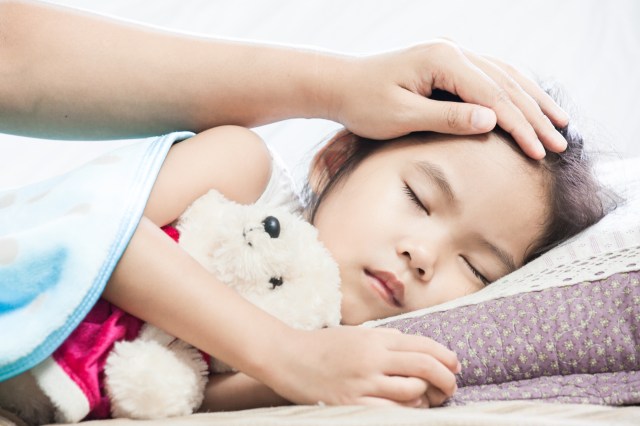Let’s face it, parenting is messy. We’re not just talking about the cracker crumbs in the bottom of your purse or the muddy footprints tracked throughout the house—we’re talking all of the boo-boos, scrapes and ouchies that come in between. In order to help you be prepared for whatever the day brings, we’ve rounded up everything you need to know about stocking a first-aid kit for your home. Keep reading to find out more.
According to the Centers for Disease Control, every year more than 9.2 million children are treated in emergency departments for nonfatal injuries, including burns, falls and even poisoning. The best way to prepare yourself? Assemble a home first aid kit. "Appropriate members of the household should know where the kit is stored and how to use each item," says Greg Walker, MD, of the American College of Emergency Physicians. "The items in the kit will be of little use unless you know how to use them."
While you're assembling your kit, The Red Cross advises being sure to include any "personal items such as medications and emergency phone numbers or other items your health-care provider may suggest," as well as all of the items listed below.
2 5x9 absorbent compress dressings
25 adhesive bandages in assorted sizes (see these biodegradable bandaids)
1 adhesive cloth tape (10 yards x 1 inch)
5 antibiotic ointment packets (one gram or more)
5 antiseptic wipe packets
Pediatric-approved pain reliever (such as Children’s Advil)
1 emergency blanket
1 breathing barrier (with one-way valve)
1 instant cold compress (there's also this kid-friendly hands-free version)
Nonlatex gloves (two pairs, size: large)
2 hydrocortisone ointment packets (one gram or more)
1 3 inch gauze roll (roller) bandage
1 roller bandage (4 inches wide)
5 3 in. x 3 in. sterile gauze pads
5 sterile gauze pads (4 x 4 inches)
Oral thermometer (non-mercury/nonglass), also within the Deluxe All Purpose First Aid Kit
2 triangular bandages
Tweezers
Your At-Home First Aid Kit Is Assembled—Now What?
We rounded up a few tips and tricks—everything from having back-up kits in your vehicles to natural remedies—that'll help make caring for your kids easier.
Keep a First Aid Kit in the Car
According to the CDC, "road traffic injuries result in as many as 50 million injuries per year," so it never hurts to be prepared on the go! The Mayo Clinic suggests all vehicle first aid kits should include adhesive tape, assorted bandage strips, super glue, eye shields and patches, cold packs, cotton balls and swabs, non-latex gloves, petroleum jelly, safety pins, scissors, tweezers and even duct tape.
Ask for Larger Medication Refills
For any prescriptions, either you or your family members take, consider asking your doctor for 60 or even 90-day refills instead of a month's supply. "That way, you’re more likely to have extras on hand for your [first aid kit]," says Geoffrey C. Wall, Pharm.D., professor of pharmacy practice at Drake University. Bonus? It could also save you money! And, don't forget to always store medicine in a safe place, away from kids' reach.
Invest in a Good Thermometer
"If your child feels warmer than usual to your touch, is sweating, shivering or seems ill, you will want to take his or her temperature before calling the doctor," recommends Nationwide Children's. "It can also show if a certain medicine is working to fight an infection." Invest in a good thermometer that can take rectal readings if you have a newborn (digital ear thermometers aren't recommended for newborns, according to the Mayo Clinic) or a digital thermometer as these are best suited for all ages—newborn, infants, children, and adults.
Keep a Variety Over-the-Counter Medicines on Hand
Over-the-counter medicines like an anti-histamine for allergic reactions, as well as a pediatric-approved pain reliever (such as Children’s Advil), should be kept on hand for pain relief. Remember that "aspirin should not be used to relieve flu symptoms or be taken by children," warns Dr. Greg Walker, MD of the American College of Emergency Physicians.
Stock Congestion Relievers
Your little one might be struggling with congestion, but it's important to note that many over-the-counter cold medicines can cause serious harm to small children. Instead, stock your first aid kit with a bulb syringe (or the ever-popular Nose Frida) to remove liquid from your child's nose. You can also use salt water (saline) nose spray or drops to loosen dried mucus in kids, per the American Academy of Pediatrics. "Put two to three drops in each nostril. Do this one side at a time," says the AAP. "Then suck out the liquid or have your child blow his or her nose." If you don't have saline spray, warm water will work just fine.
Be Ready for Wound Care
Childhood is full of scrapes, cuts, burns and occasionally, larger wounds. The Mayo Clinic recommends cleaning the wound with water (not hydrogen peroxide as this can be irritating!) and removing any debris with tweezers sterilized with alcohol.
Download First Aid Apps
Sick kids? Yes, there's an app for that too! There are dozens of helpful apps that provide information on treating little patients, like the Baby and Child First Aid App from the British Red Cross. There is even a CVS MinuteClinic Video Appointment where you can see a doctor right from your phone!
Don't Forget the Natural Remedies
While you're revamping your home's first aid station, it's important not to overlook the natural remedies you can use for basic ailments. Adding a bottle of elderberry syrup to your kit can help ease your child's cold symptoms, while baking soda can treat bee stings, and honey will soothe a sore throat! Essential oils (like these kid-safe blends from Oilogic) can also provide relief from various ailments, including allergies and bug bites. See our other first aid hacks here.
—Kaitlyn Kirby
RELATED STORIES:
First-Aid Hacks That Will Save Your Summer
12 Mom-Tested Home Remedies to Fight Colds & Flu
What Every Mom Has in Her Purse
